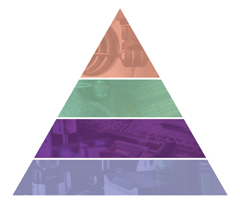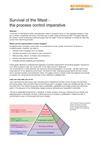Réglages des procédés
Les réglages automatisés par palpage peuvent être jusqu’à 10 fois plus rapides qu’avec les méthodes manuelles.
Les commandes dans la couche de réglage des procédés dans la Productive Process Pyramid™ définissent la relation entre la machine, la pièce et les outils avant le début de l’usinage. Ces contrôles prédictifs automatisés font en sorte que les premiers usinages soient bons.
La garantie de premiers usinages corrects

La couche Réglages des procédés dans la Pyramid™, s’intéresse aux sources de variations telles que l’emplacement de la pièce, la taille des outils et les correcteurs sur la machine qui alignent les usinages par rapport à la pièce.
Il s’agit de contrôles prédictifs appliqués juste avant le début de l’usinage.
Le réglage d’outil détermine :
- La longueur à partir de la position du repère de jauge de broche pour déterminer un correcteur de hauteur et vérifier que la longueur est dans les tolérances spécifiées
- Le diamètre en rotation pour déterminer un correcteur de cote d’outil
Le réglage de pièce détermine :
- L’identification des composants pour sélectionner le programme CN correct
- La position d’une entité de référence pour établir un système de coordonnées de travail (SCT)
- La taille du débit matière ou de la pièce pour calculer la surépaisseur et les passes de dégrossissage
- L’orientation d’une pièce (par rapport aux axes machine) afin d’établir la rotation de coordonnées
Le réglage machine détermine :
- L’alignement d’un axe rotatif, d’un indexeur ou des bridages nécessaires exigés pour positionner et tenir des composants
- La position du centre de rotation d’un indexeur et/ou de points de référence sur des bridages
Contrôles prédictifs
Les réglages automatisés par palpage peuvent être jusqu’à 10 fois plus rapides qu’avec les méthodes manuelles, et ils permettent de consacrer plus de temps à l’usinage.
Le palpage est, lui aussi, prévisible. Vous saurez donc combien de temps prend le réglage et vous pourrez planifier en fonction.
Le réglage de procédés par palpage sur machine peut être entièrement géré par logiciel. Les opérateurs qualifiés ne sont ainsi plus nécessaires pour prendre des mesures, effectuer des calculs et saisir des changements de correcteurs.
Les palpeurs de contrôle de pièces à usiner, systèmes de réglage des outils et le logiciel Productivity+™ de Renishaw sont des outils essentiels pour une configuration rapide, automatique et répétable des opérations d’usinage.
Documents
-
 Brochure : Solutions métrologiques pour une gestion productive des procédés
Brochure : Solutions métrologiques pour une gestion productive des procédés
Transformer vos performances de fabrication en faisant appel aux experts en gestion de procédés
-
 White paper: Survival of the fittest - the process control imperative [en]
White paper: Survival of the fittest - the process control imperative [en]
In tough times, manufacturers focus on reducing their operating costs, but may not be able to afford to spend their way out by buying more productive machinery. With that pathway closed, what are the opportunities for radically reducing costs without replacing existing machines? This paper explores four areas where substantial savings can be found if firms are prepared to change the way they control their machining processes.

